Abstract
In this paper, biochar was modified by cetyltrimethylammonium bromide (CTAB) and KOH solution, and it was characterized by TGA, FT-IR, XRD, BET, SEM. Then, the modified biochar (MB) was used to immobilize free laccase (FL) by adsorption method to prepare modified biochar immobilize laccase (MBL). The adsorption and degradation performance for 2,4-DCP via MB, FL, MBL were studied. The results showed that under the optimal conditions, the adsorption rate of MB on 2,4-DCP was up to 42.5%, adsorption capacity was 85.13 mg/g, and the adsorption of 2,4-DCP by MB was proved to conform to the pseudo-second-order model and the Langmuir adsorption isotherm model; the maximum degradation rate of FL on 2,4-DCP was 97.7%, and the degradation of 2,4-DCP by FL was proved to conform to the first-order kinetic model; under the optimal conditions, the removal rate of MBL on 2,4-DCP can reach almost 100%. MBL combines physical–chemical adsorption and biodegradation, and the contribution of biodegradation is greater than adsorption. Finally, the possible degradation mechanism and pathways of 2,4-DCP were given via high-performance liquid chromatography (HPLC) analysis and gas chromatography-mass spectrometry (GC–MS) analysis.
Graphic abstract











Similar content being viewed by others
References
Adeola A (2018) Fate and toxicity of chlorinated phenols of environmental implications: a review medicinal and analytical chemistry. Int J 2:000126
Ahmad A et al (2019) Methods of enzyme immobilization on various supports enzymatic fuel cells. Mater Appl 44:1–28
Ammar HB, Brahim MB, Abdelhédi R, Samet Y (2016) Green electrochemical process for metronidazole degradation at BDD anode in aqueous solutions via direct and indirect oxidation. Sep Purif Technol 157:9–16
Bernal C, Rodriguez K, Martinez R (2018) Integrating enzyme immobilization and protein engineering: an alternative path for the development of novel and improved industrial biocatalysts. Biotechnol Adv 36:1470–1480
Bhattacharya SS, Karmakar S, Banerjee R (2009) Optimization of laccase mediated biodegradation of 2, 4-dichlorophenol using genetic algorithm water research. Water Res 43:3503–3510
Bilal M, Asgher M, Parra-Saldivar R, Hu H, Wang W, Zhang X, Iqbal HM (2017) Immobilized ligninolytic enzymes: an innovative and environmental responsive technology to tackle dye-based industrial pollutants–a review. Sci Total Environ 576:646–659
Catherine H, Penninckx M, Frédéric D (2016) Product formation from phenolic compounds removal by laccases: A review. Environ Technol Innovat 5:250–266
Cooper GS, Jones S (2008) Pentachlorophenol and cancer risk: focusing the lens on specific chlorophenols and contaminants. Environ Health Perspect 116:1001–1008
Cui J, Ren S, Sun B, Jia S (2018) Optimization protocols and improved strategies for metal-organic frameworks for immobilizing enzymes: Current development and future challenges. Coord Chem Rev 370:22–41
d’Acunzo F, Galli C, Masci B (2002) Oxidation of phenols by laccase and laccase-mediator systems: Solubility and steric issues. Eur J Biochem 269:5330–5335
Davin LB, Wang H-B, Crowell AL, Bedgar DL, Martin DM, Sarkanen S, Lewis NG (1997) Stereoselective bimolecular phenoxy radical coupling by an auxiliary (dirigent) protein without an active center. Science 275:362–367
Ezzati R (2019) Derivation of pseudo first order pseudo second order and modified pseudo-first-order rate equations from langmuir and freundlich isotherms for adsorption. Chem Eng J 123:705
Fernández-Fernández M, Sanromán MÁ, Moldes D (2013) Recent developments and applications of immobilized laccase. Biotechnol Adv 31:1808–1825
García-Delgado C, Eymar E, Camacho-Arévalo R, Petruccioli M, Crognale S, D’Annibale A (2018) Degradation of tetracyclines and sulfonamides by stevensite-and biochar-immobilized laccase systems and impact on residual antibiotic activity. J Chem Technol Biotechnol 93:3394–3409
Giardina P, Faraco V, Pezzella C, Piscitelli A, Vanhulle S, Sannia G (2010) Laccases: a never-ending story. Cell Mole Life Sci 67:369–385
Gupta V, Carrott P, Singh R, Chaudhary M, Kushwaha S (2016) Cellulose: a review as natural modified and activated carbon adsorbent. Bioresour Technol 216:1066–1076
Inyang MI et al (2016) A review of biochar as a low-cost adsorbent for aqueous heavy metal removal. Critical Rev Environ Sci Technol 46:406–433
Jin H, Hanif MU, Capareda S, Chang Z, Huang H, Ai Y (2016) Copper (II) removal potential from aqueous solution by pyrolysis biochar derived from anaerobically digested algae-dairy-manure and effect of KOH activation. J Environ Chem Eng 4:365–372
Jun LY et al (2019) An overview of immobilized enzyme technologies for dye phaenolic removal from wastewater. J Environ Chem Eng 102:961
Kaczmarek MB, Kwiatos N, Szczęsna-Antczak M, Bielecki S (2017) Laccases–enzymes with an unlimited potential. Biotechnol Food Sci 81:263
Karimi-Maleh H et al (2020a) An amplified voltammetric sensor based on platinum nanoparticle/polyoxometalate/two-dimensional hexagonal boron nitride nanosheets composite and ionic liquid for determination of N-hydroxysuccinimide in water samples. J Mole Liquid 310:113185
Karimi-Maleh H et al (2020b) The role of magnetite/graphene oxide nano-composite as a high-efficiency adsorbent for removal of phenazopyridine residues from water samples, an experimental/theoretical investigation. J Mole Liquids 298:112040
Karimi-Maleh H, Fakude CT, Mabuba N, Peleyeju GM, Arotiba OA (2019) The determination of 2-phenylphenol in the presence of 4-chlorophenol using nano-Fe3O4/ionic liquid paste electrode as an electrochemical sensor. J Colloid Interface Sci 554:603–610
Karimi-Maleh H et al (2020b) Tuning of metal oxides photocatalytic performance using Ag nanoparticles integration. J Mol Liq 314:113588
Karimi-Maleh H, Cellat K, Arıkan K, Savk A, Karimi F, Şen F (2020a) Palladium-Nickel nanoparticles decorated on Functionalized-MWCNT for high precision non-enzymatic glucose sensing. Mater Chem Phys 250:123042
Kilcawley KN, Wilkinson MG, Fox PF (2002) Determination of key enzyme activities in commercial peptidase and lipase preparations from microbial or animal sources. Enzyme Microbial Technol 31:310–320
Mohammadian M, Fathi-Roudsari M, Mollania N, Badoei-Dalfard A, Khajeh K (2010) Enhanced expression of a recombinant bacterial laccase at low temperature and microaerobic conditions: purification and biochemical characterization. J Indust Microbiol Biotechnol 37:863–869
Naiki H, Nakakuki K (1996) First-order kinetic model of Alzheimer’s beta-amyloid fibril extension in vitro Laboratory investigation. A J Tech Method Pathol 74:374–383
Novoa C et al (2019) KnowVolution of a fungal laccase toward alkaline pH. ChemBioChem 20:1458–1466
Nunes CS, Kunamneni A (2018) Laccases—properties and applications. In: Enzymes in human and animal nutrition. Elsevier, pp 133–161
Peng H, Gao P, Chu G, Pan B, Peng J, Xing B (2017) Enhanced adsorption of Cu (II) and Cd (II) by phosphoric acid-modified biochars. Environ Pollut 229:846–853
Poorakbar E et al (2018) Synthesis of magnetic gold mesoporous silica nanoparticles core shell for cellulase enzyme immobilization: improvement of enzymatic activity and thermal stability. Process Biochem 71:92–100
Puanngam M, Unob F (2008) Preparation and use of chemically modified MCM-41 and silica gel as selective adsorbents for Hg (II) ions. J Hazard Mater 154:578–587
Qayoom A, Talha M, Kamal A, Siddiqui M, Viqar A (2018) Indigenous kaolinite ore as cost effective adsorbent for re-refining of used lubricating oil. Revue des Energies Renouvelables 21:473–485
Rajapaksha AU et al (2016) Engineered/designer biochar for contaminant removal/immobilization from soil and water: potential and implication of biochar modification. Chemosphere 148:276–291
Ren D, Yu H, Wu J, Wang Z, Zhang S, Zhang X, Gong X (2020) The study on adsorption behavior of 2, 4-DCP in solution by biomass carbon modified with CTAB-KOH. Water Sci Technol 82:1535–1546
Rooney MR, Lutsey PL, Bhatti P, Prizment A (2019) Urinary 2, 5-dicholorophenol and 2, 4-dichlorophenol concentrations and prevalent disease among adults in the National Health and Nutrition Examination Survey (NHANES). Occup Environ Med 76:181–188
Saptiama I et al (2017) Mesoporous alumina as an effective adsorbent for molybdenum (Mo) toward instant production of radioisotope for medical use. Bull Chem Soc Japan 90:1174–1179
Sdiri A, Khairy M, Bouaziz S, El-Safty S (2016) A natural clayey adsorbent for selective removal of lead from aqueous solutions. Appl Clay Sci 126:89–97
Taki K, Sharma S (2020) Synthesis of Bentonite Clay-Based Geopolymer and Its Application in the Treatment of Expansive Soil. In: Advances in Computer Methods and Geomechanics. Springer, pp 133–143
Tisch M, Bergenthal S, Maier H (2002) Genotoxic effect of PCP and lindane on human epithelial tonsil cells. Hno 50:920–927
Villegas LGC, Mashhadi N, Chen M, Mukherjee D, Taylor KE, Biswas N (2016) A short review of techniques for phenol removal from wastewater. Curr Pollut Reports 2:157–167
Wan X, Zhan Y, Long Z, Zeng G, He Y (2017) Core@ double-shell structured magnetic halloysite nanotube nano-hybrid as efficient recyclable adsorbent for methylene blue removal. Chem Eng J 330:491–504
Wang Z et al (2019) Remediation and improvement of 2 4-dichlorophenol contaminated soil by biochar-immobilized laccase. Environ Technol 26:1–14
Wang Z et al (2020) Repairing compound-contaminated soil using EK-laccase combination repairing technology. Polish J Environ Stud 29:2403–2411
Yang K et al (2018) New insights for risks of chlorophenols (CPs) exposure: inhibition of UDP-glucuronosyltransferases (UGTs). Chemosphere 206:9–16
Yang X et al (2019) Surface functional groups of carbon-based adsorbents and their roles in the removal of heavy metals from aqueous solutions: a critical review. Chem Eng J. https://doi.org/10.1016/j.cej.2019.02.119
Yang J, Huang Y, Yang Y, Yuan H, Liu X (2015) Cagelike mesoporous silica encapsulated with microcapsules for immobilized laccase and 2 4-DCP degradation. J Environ Sci 38:52–62
Yang Y, Song S, Zhao Z (2017) Graphene oxide (GO)/polyacrylamide (PAM) composite hydrogels as efficient cationic dye adsorbents. Colloid Surf A: Physicochem Eng Aspects 513:315–324
Zdarta J, Meyer AS, Jesionowski T, Pinelo M (2018) A general overview of support materials for enzyme immobilization: characteristics, properties, practical utility. Catalysts 8:92
Zhang J, Liu X, Xu Z, Chen H, Yang Y (2008) Degradation of chlorophenols catalyzed by laccase. Int Biodeterior Biodegradation 61:351–356
Zhang G, Zhao P, Hao L, Xu Y, Cheng H (2019) A novel amine double functionalized adsorbent for carbon dioxide capture using original mesoporous silica molecular sieves as support. Sep Purif Technol 209:516–527
Zhao W, Ramos K (1998) Cytotoxic response profiles of cultured rat hepatocytes to selected aromatic hydrocarbons. Toxicol in vitro 12:175–182
Zhou Y, Jin X-Y, Lin H, Chen Z-L (2011) Synthesis, characterization and potential application of organobentonite in removing 2 4-DCP from industrial wastewater. Chem Eng J 166:176–183
Zhou N, Chen H, Xi J, Yao D, Zhou Z, Tian Y, Lu X (2017) Biochars with excellent Pb (II) adsorption property produced from fresh and dehydrated banana peels via hydrothermal carbonization. Bioresour Technol 232:204–210
Acknowledgements
The authors wish to thank all who assisted in conducting this work.
Funding
This work was supported by the Project of Excellent Fund in Hubei (Grant No 2018CFA067), the National Natural Science Foundation of China (Grant No 41571306), the Major Project of Science and Technology research Program of the Hubei Provincial Department of Education (Grant No D20181101), the National Natural Science Foundation of China (Grant No 41501537) and Hubei Key Laboratory for Efficient Utilization and Agglomeration of Metallurgic Mineral Resources (Grant No 2017zy003).
Author information
Authors and Affiliations
Contributions
ZW contributed the conceptualization, methodology, writing-original draft preparation, data curation. DR contributed the conceptualization, writing-reviewing and editing. JW contributed the conceptualization and investigation. SJ, HY and YC contributed the investigation. At last, SZ and XZ contributed the writing-reviewing and editing. All authors read and approved the final manuscript.
Corresponding author
Ethics declarations
Conflict of interest
The authors declare that they have no competing interests.
Additional information
Editorial responsibility: Fatih ŞEN.
Rights and permissions
About this article
Cite this article
Wang, Z., Ren, D., Wu, J. et al. Study on adsorption-degradation of 2,4-dichlorophenol by modified biochar immobilized laccase. Int. J. Environ. Sci. Technol. 19, 1393–1406 (2022). https://doi.org/10.1007/s13762-021-03151-2
Received:
Revised:
Accepted:
Published:
Issue Date:
DOI: https://doi.org/10.1007/s13762-021-03151-2




